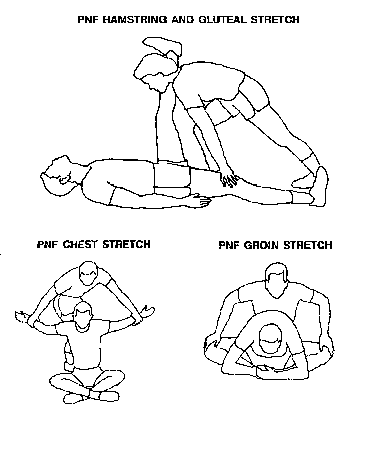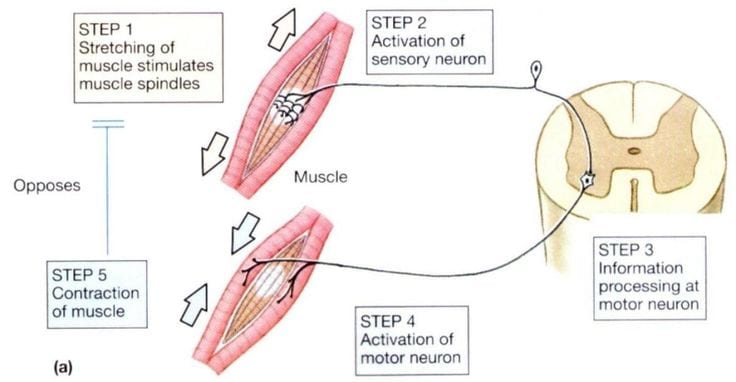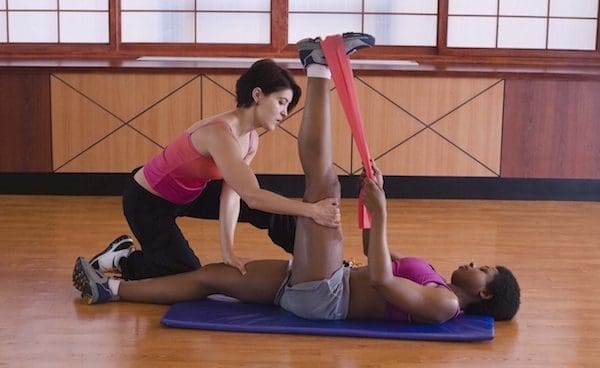Flexibility is critical for athletes and non-athletes alike. It allows people to move freely and easily in their everyday life and can also help prevent injury or aggravated conditions during physical activities. One of the best methods to maximize flexibility is through stretching. However, research suggests that not all stretching techniques are created equal. Proprioceptive neuromuscular facilitation, or P.N.F., stretching is depends on reflexes to produce deeper stretches which increase flexibility.
Table of Contents
What is P.N.F. stretching?
Proprioceptive neuromuscular facilitation (PNF) is a more complex form of endurance training which involves both the stretching and contraction of the muscle group being targeted. PNF stretching was initially developed as a form of rehabilitation, and to that effect, it’s very effective. It’s also great for targeting specific muscle groups, and also, while it helps increase flexibility, it also enhances muscle power.
As stated by the International PNF Association, P.N.F. stretching was developed by Dr. Herman Kabat in the 1940’s as a means to take care of neuromuscular ailments, including polio and multiple sclerosis. Proprioceptive neuromuscular facilitation techniques have since gained recognition with healthcare professionals, such as chiropractors, physical therapists and other fitness professionals. Based on research from the University of Queensland, PNF stretching may be the best stretching procedure for increasing range of motion.
How Does Proprioceptive Neuromuscular Facilitation Function?
While there are multiple PNF stretching techniques, all of these rely on extending a muscle to its own limitation. Doing so causes the inverse myotatic reflex, a protective reflex that calms the muscle to prevent injury. P.N.F. induces the brain to think “I do not need that muscle to rip” and sends a message to let the muscle relax a bit more than it would normally.
You know the feeling when you stretch a muscle? It feels great when you stretch it until you move nearer to the end of its range of movement and it starts to feel extremely tight and even painful. It’s similar to a flexible band that does not want to stretch any farther.This is known as the myotatic reflex, which is the human body’s natural method of protecting your muscles from stretching too far. It is possible to conquer this to an extent by gradually extending and exhaling to decrease tension in the muscle.
However, proprioceptive neuromuscular facilitation, or PNF, stretching tricks your nervous system into relaxing the myotatic reflex, enabling your muscles to extend further than what’s attainable using a conventional style of stretching. All PNF stretching requires is that you stretch a muscle and then forcefully contract that muscle before stretching it again. As you proceed into the stretch after the contraction, you will be able to stretch farther that you did earlier. This permits you to create more length in the muscle and receives a much greater flexibility benefit from the stretch. P.N.F. stretching consists of several techniques which can help achieve the same effect as described above.


Hold-Relax Stretch
This type of PNF stretch relies on the concept of autogenic inhibition. By stretching the muscle and after using an isometric contraction of the muscle, it’s possible to decrease the activity (or tone) of the muscle and deceive the myotatic reflex to permit for a more significant stretch. To perform this technique, stretch a muscle as far as you can, remember, it shouldn’t be painful, and then hold the stretch for 10 seconds. Next, contract that muscle as forcefully as possible against an immovable object. Hold this for 5 minutes. Now move into a stretch, using a partner’s assistance if needed, which ought to be deeper than what you attained before. Repeat the stretch-contraction order three times for each muscle.
Contract-Relax, Antagonist-Contract Stretch
Your system is wired so that two muscles cannot shorten at precisely the exact same time, otherwise they’d fight against one another, and you would not be able to move. So when you consciously contract a muscle, your nervous system automatically sends an indication to the opposing muscle, or antagonist, that it ought to relax so that your joint can proceed. This is called reciprocal inhibition. This variant of PNF benefits from reciprocal inhibition. It resembles the hold-relax stretch but entails a forceful contraction of the opposing muscle to the one being extended in order to move deeper into the stretch.
To perform this technique, stretch a muscle as far as you can, again, remember it shouldn’t be painful, and hold the stretch for 10 seconds. Next, contract that muscle as aggressively as you can against an immovable object, such as your partner’s chest. Hold this for 5 seconds. Now use the opposing muscle to pull yourself back to the stretch. Again for the hamstring stretch, this would be your hip flexors. Your partner won’t have to supply as much assistance as the hold-relax stretch technique, but can give an excess drive and will help you maintain the stretch if needed. Repeat the sequence three times for each muscle.
Contract-Relax Stretch
Finally, the third type of PNF stretch closely resembles the hold-relax stretch but rather entails contracting the muscle through an active assortment of motion. To perform this technique for a hamstring stretch, for instance, you’d extend the muscle for 10 seconds and slowly lower your leg into a table. Now increase your leg back around 90 degrees and also have a partner move you into the next stretch.

Dr. Alex Jimenez’s Insight
Proprioceptive Neuromuscular Facilitation, or PNF, is a rehabilitation stretching technique used to help increase flexibility as well as improve muscle elasticity. P.N.F. has been demonstrated to have a positive effect on active and passive range of motion because it can increase the length of the muscle and neuromuscular efficiency. Stretching has long been seen as beneficial to enhance performance and decrease risk of injury during physical activities. Proprioceptive neuromuscular facilitation stretching can also improve function and range of motion following an injury. Proper protocol should be followed when performing PNF stretching to attain and maintain the benefits of these techniques.
A Word of Caution Regarding PNF Stretching
Certain precautions need to be taken when performing proprioceptive neuromuscular facilitation, or PNF, stretches because they can place additional amounts of stress, pressure and/or tension on the targeted muscle group, which can boost the risk of soft tissue injury. To help reduce this risk, it’s important to incorporate a conditioning stage before a maximum, or extreme effort is utilized.
Additionally, before undertaking any form of stretching it is extremely important that a comprehensive warm up is completed. Warming up prior to stretching does a variety of valuable things, but mainly its objective is to prepare the body and mind for more strenuous physical activities. Among the ways it accomplishes this is by helping to increase the body’s core temperature whilst also increasing the body’s muscle dimensions. This is imperative to ensure the maximum benefit is obtained from your stretching. The scope of our information is limited to chiropractic as well as to spinal injuries and conditions. To discuss the subject matter, please feel free to ask Dr. Jimenez or contact us at 915-850-0900 .
Curated by Dr. Alex Jimenez
Additional Topics: Sciatica
Sciatica is medically referred to as a collection of symptoms, rather than a single injury and/or condition. Symptoms of sciatic nerve pain, or sciatica, can vary in frequency and intensity, however, it is most commonly described as a sudden, sharp (knife-like) or electrical pain that radiates from the low back down the buttocks, hips, thighs and legs into the foot. Other symptoms of sciatica may include, tingling or burning sensations, numbness and weakness along the length of the sciatic nerve. Sciatica most frequently affects individuals between the ages of 30 and 50 years. It may often develop as a result of the degeneration of the spine due to age, however, the compression and irritation of the sciatic nerve caused by a bulging or herniated disc, among other spinal health issues, may also cause sciatic nerve pain.

Post Disclaimer
Professional Scope of Practice *
The information on this blog site is not intended to replace a one-on-one relationship with a qualified healthcare professional or licensed physician and is not medical advice. We encourage you to make healthcare decisions based on your research and partnership with a qualified healthcare professional.
Blog Information & Scope Discussions
Welcome to El Paso's Premier Wellness and Injury Care Clinic & Wellness Blog, where Dr. Alex Jimenez, DC, FNP-C, a board-certified Family Practice Nurse Practitioner (FNP-BC) and Chiropractor (DC), presents insights on how our team is dedicated to holistic healing and personalized care. Our practice aligns with evidence-based treatment protocols inspired by integrative medicine principles, similar to those found on this site and our family practice-based chiromed.com site, focusing on restoring health naturally for patients of all ages.
Our areas of chiropractic practice include Wellness & Nutrition, Chronic Pain, Personal Injury, Auto Accident Care, Work Injuries, Back Injury, Low Back Pain, Neck Pain, Migraine Headaches, Sports Injuries, Severe Sciatica, Scoliosis, Complex Herniated Discs, Fibromyalgia, Chronic Pain, Complex Injuries, Stress Management, Functional Medicine Treatments, and in-scope care protocols.
Our information scope is limited to chiropractic, musculoskeletal, physical medicine, wellness, contributing etiological viscerosomatic disturbances within clinical presentations, associated somato-visceral reflex clinical dynamics, subluxation complexes, sensitive health issues, and functional medicine articles, topics, and discussions.
We provide and present clinical collaboration with specialists from various disciplines. Each specialist is governed by their professional scope of practice and their jurisdiction of licensure. We use functional health & wellness protocols to treat and support care for the injuries or disorders of the musculoskeletal system.
Our videos, posts, topics, subjects, and insights cover clinical matters and issues that relate to and directly or indirectly support our clinical scope of practice.*
Our office has made a reasonable effort to provide supportive citations and has identified relevant research studies that support our posts. We provide copies of supporting research studies available to regulatory boards and the public upon request.
We understand that we cover matters that require an additional explanation of how they may assist in a particular care plan or treatment protocol; therefore, to discuss the subject matter above further, please feel free to ask Dr. Alex Jimenez, DC, APRN, FNP-BC, or contact us at 915-850-0900.
We are here to help you and your family.
Blessings
Dr. Alex Jimenez DC, MSACP, APRN, FNP-BC*, CCST, IFMCP, CFMP, ATN
email: coach@elpasofunctionalmedicine.com
Licensed as a Doctor of Chiropractic (DC) in Texas & New Mexico*
Texas DC License # TX5807
New Mexico DC License # NM-DC2182
Licensed as a Registered Nurse (RN*) in Texas & Multistate
Texas RN License # 1191402
ANCC FNP-BC: Board Certified Nurse Practitioner*
Compact Status: Multi-State License: Authorized to Practice in 40 States*
Graduate with Honors: ICHS: MSN-FNP (Family Nurse Practitioner Program)
Degree Granted. Master's in Family Practice MSN Diploma (Cum Laude)
Dr. Alex Jimenez, DC, APRN, FNP-BC*, CFMP, IFMCP, ATN, CCST
My Digital Business Card



